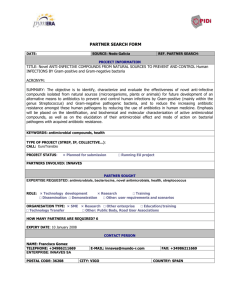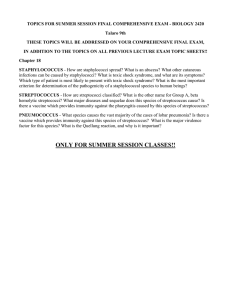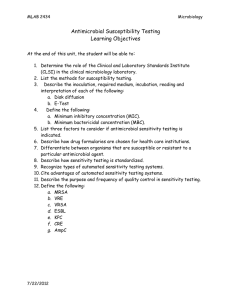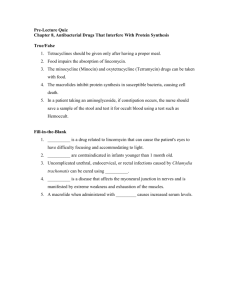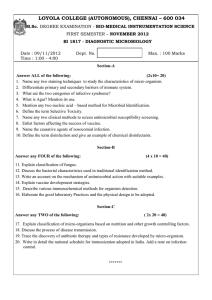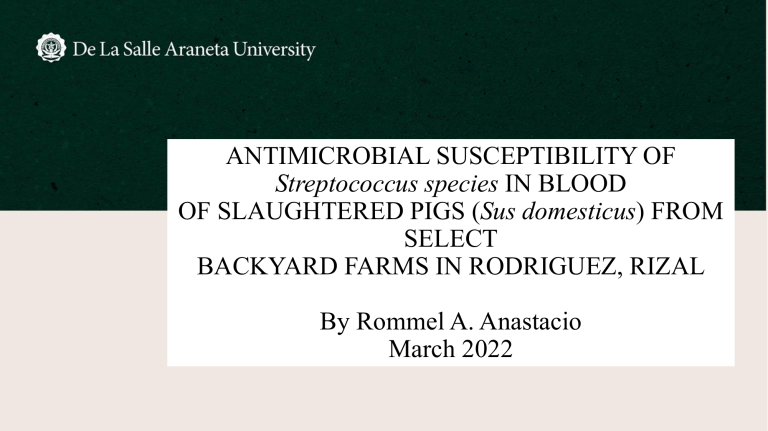
ANTIMICROBIAL SUSCEPTIBILITY OF Streptococcus species IN BLOOD OF SLAUGHTERED PIGS (Sus domesticus) FROM SELECT BACKYARD FARMS IN RODRIGUEZ, RIZAL By Rommel A. Anastacio March 2022 • Streptococcus suis is a commensal of the respiratory tract and commonly seen in tonsil of a healthy swine. • It is facultative anaerobe, gram positive non- motile coccus that produces α- hemolysis in blood agar. • causes death by septic shock or meningitis and purulent arthritis occurred among post weaned piglets • According to the article antimicrobial resistance of Streptococcus spp. and Salmonella species isolates has increased from select swine and poultry farms in region Ⅲ and Ⅳ in the Philippines. • In swine backyard farms in regions Ⅲ and Ⅳ of the Philippines the improper usage of antibiotics such as amoxicillin, penicillin G and erythromycin which are frequently used in treating common diseases in swine has increased the antimicrobial resistance of the Streptococcus suis Statement of the Problem This study was conducted to determine the antimicrobial susceptibility of Streptococcus species isolates in the blood of swine collected from select backyard farms in Rodriguez, Rizal. Specifically, it sought to answer the following questions: 1. What will be the frequency of Streptococcus species isolated in the blood of slaughtered pigs from select backyard farms from Rodriguez, Rizal? 2. Will frequency antimicrobial susceptibility of Streptococcus species isolated in the blood of slaughtered pigs vary among amoxicillin, erythromycin, lincomycin, tetracycline and trimethoprim sulfamethoxazole? 3. Will there be significant difference in the frequency antimicrobial susceptibility of Streptococcus species isolated in the blood of slaughtered pigs to amoxicillin, erythromycin, lincomycin, tetracycline and trimethoprim sulfamethoxazole? 4. Will frequency susceptibility of Streptococcus species to amoxicillin, erythromycin, lincomycin, tetracycline and trimethoprim sulfamethoxazole in the blood of slaughtered pigs vary among backyard farms? Hypotheses of the Study 1. The frequency antimicrobial susceptibility of Streptococcus species isolated from the blood of slaughtered pigs does not vary among amoxicillin, erythromycin, lincomycin, tetracycline and trimethoprim sulfamethoxazole. 2. There is no significant difference in the antimicrobial susceptibility of Streptococcus species isolated in the blood of slaughtered pigs to amoxicillin, erythromycin, lincomycin, tetracycline and trimethoprim sulfamethoxazole 3. The frequency antimicrobial susceptibility to amoxicillin, erythromycin, lincomycin, tetracycline and trimethoprim sulfamethoxazole of Streptococcus species isolated in the blood of slaughtered pigs does not vary mong backyard farms. Significance of the Study • The study tried to determine the antimicrobial susceptibility of Streptococcus species isolates in the blood of pigs from select backyard farms in Rodriguez, Rizal • The study will inform the consumers of pig blood, about the importance of food safety specially the presence of S. suis and the disease it causes in humans. • This study will benefit swine veterinary practitioners who have encountered S. suis as the cause of respiratory infections in pigs and discover the infection no longer responds to antibiotic treatment. • Slaughterhouse personnel who are exposed to S. suis. and veterinary students who are performing similar studies and farm owners will be informed on the public health importance of S. suis will also benefit from this study. Scope and Limitations of the Study The study was performed to determine the antimicrobial susceptibility of Strep. species isolated in pig blood from select backyard farms in Rodriguez Rizal. One hundred ml (100ml). of fresh blood sample was collected aseptically, direct from the swine while it was bled, placed in a sterile screwcap plastic bottle, arranged in an ice box immediately and labeled. Twenty (20) fresh pig blood samples came from three (3) select backyard farms when the pigs were slaughtered at Montalban Slaughterhouse at Rodriguez Rizal. The fresh swine blood sample were submitted to BioAsset Veterinary Microbiology Diagnostic laboratory in Batangas for purification and identification of Strep. species isolates based on typical colony characteristics in BHI blood agar, Gramstaining and biochemical tests. The Strep. species isolates were subjected to Kirby-Bauer disc diffusion method to determine their antimicrobial susceptibility to amoxicillin, erythromycin, lincomycin, tetracycline and TMPS. The area of zone of inhibition was measured using Vernier caliper to the nearest mm. Pearson square method was used to determine if there is significant difference in the frequency susceptibility of Strep. species to amoxicillin, erythromycin, lincomycin, tetracycline and trimethoprim sulfamethoxazole. Time and Place of Study The study was conducted from March 2021 to March 2022. The writing of the manuscript was done at the residence of the author. The collection of fresh swine blood samples was performed at a select slaughterhouse in Rodriguez, Rizal. Streptococcus species were isolated, identified and subjected to Kirby Bauer disk diffusion method at the at BioAssets Veterinary Research and Diagnostic Laboratory in NDN Building, 34 Pres. J.P. Laurel Highway, San Roque, Santo Tomas Batangas. Finalization, analysis and interpretation of the results was done under the supervision of the thesis adviser, Dr. Edelmira P. Guno. Summary • This study was conducted to determine the antimicrobial susceptibility of Streptococcus species isolates in the blood of pigs from select backyard farms in Rodriguez, Rizal. Twenty (20) blood samples were collected aseptically from pigs from three select backyards farms at the slaughterhouse in Rodriguez, Rizal. The pig blood samples were submitted to a Microbiology Diagnostic Laboratory in Batangas for isolation and identification of the Streptococcus species. • The purified isolates of Streptococcus species from pig blood samples were then subjected to antimicrobial susceptibility test using amoxicillin, erythromycin, lincomycin, tetracycline and TMPS. The antimicrobial susceptibility was based on the diameter of zone of inhibition, measured to the nearest millimeter. The levels of antimicrobial susceptibility, frequency and percentage frequency were gathered and recorded. Then it was classified as sensitive (S), intermediate (I) and resistant (R). • Based on the results of the study, out of twenty (20) pig blood samples collected, three (3) were isolated and identified as Streptococcus species, with one isolate from each of the three backyard farms. All three isolates were sensitive to amoxicillin, and all are resistant to lincomycin and TMPS, one (1) species from farm A and B are resistant to erythromycin, one (1) from farm A and C were both resistant to tetracycline and one was intermediate to erythromycin and one was intermediate to tetracycline. • Based on the results there is a significant difference in the frequency of antimicrobial susceptibility of Streptococcus species isolated from pig blood. The Streptococcus species isolated from backyard farms are all sensitive to amoxicillin but the other antimicrobials are no longer effective against the isolates. Conclusion 1. The frequency of antimicrobial susceptibility of Streptococcus species. isolates from the blood of slaughtered pigs vary among amoxicillin, erythromycin, lincomycin, tetracycline and trimethoprim sulfamethoxazole. The null hypothesis is rejected. 2. There is a significant difference in the antimicrobial susceptibility of Streptococcus species isolates to amoxicillin, erythromycin, lincomycin, tetracycline and trimethoprim sulfamethoxazole from the blood of slaughtered pigs. The null hypothesis is rejected. 3. The antimicrobial susceptibility of Streptococcus species isolates in the blood of slaughtered pigs to amoxicillin, erythromycin, lincomycin, tetracycline and trimethoprim sulfamethoxazole does not vary among backyard farms. The null hypothesis is accepted. Recommendation 1. The three swine backyard farms should use amoxicillin to treat Streptococcus suis infections in their herd and avoid the use of the antimicrobial drugs such as erythromycin, lincomycin, tetracycline and trimethoprim sulfamethoxazole because the bacteria isolated are already resistant. 2. Backyard farmers must follow the veterinarian recommendations on the use of antimicrobial drugs in the treatment of diseases in their swine herd and must follow proper use of antibiotics to prevent antimicrobial resistance. 3. Further study on isolation of Streptococcus suis from meningeal swab and cerebral spinal fluid from cases of meningitis and joint fluid from arthritis cases in pigs. 4. Future researchers are advised to gather larger sample size from pigs from various slaughterhouse in the Philippines for more results to isolate Streptococcus suis and subject them to antimicrobial susceptibility test. 5. Buyers and consumers are encouraged to cook the pig blood thoroughly. Recommended to heat blood at least 100oC/10minutes to avoid food poisoning.

